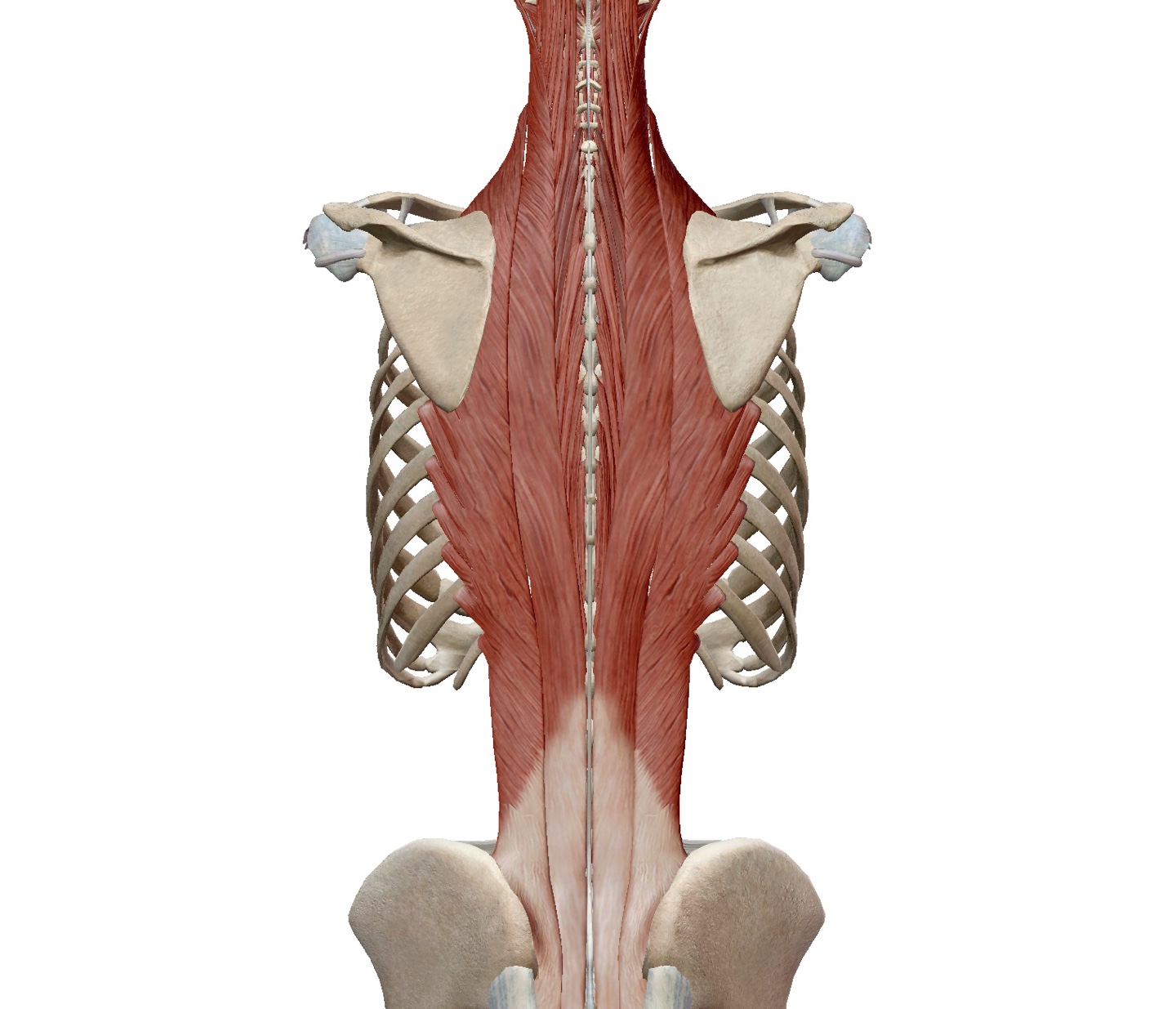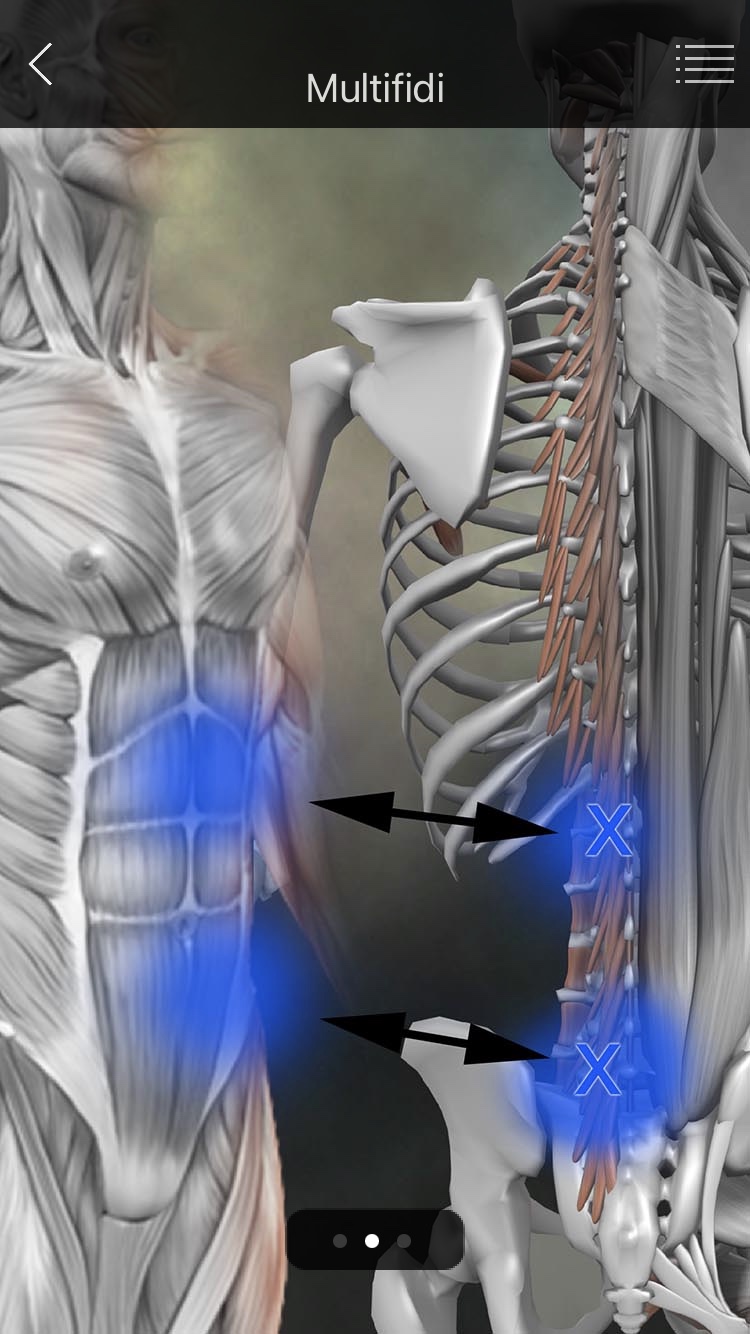
척추기립근(Erector spinae) 이란 척주(Vertebral column)의 주변을 감싸고있는 근육들의 총 모음이다. 크게 표층부와 심층부로 2가지로 분류가 되고 그 중에서도 위치와 역할에 따라 개별적인 명칭이 붙는다.
표층부에 위치한 척추기립근(Erector spinae)은 척추의 극돌기(Spinous process) 기준으로부터 극근(Spinalis), 최장근(Longissimus), 장늑근(Iliocostalis)으로 나뉘며 이 근육들도 위치에 따라서 극근(Spinalils)은 경극근(Spinalis cervicis), 흉극근(Spinalis thoracis)으로, 최장근(Longissimus)은 두최장근(Longissimus capitis), 경최장근(Longissimus cervicis), 흉최장근(Longissimus thoracis)으로, 장늑근(Iliocostalis)은 경장늑근(Iliocostalis cervicis), 흉장늑근(Iliocostalis thoracis), 요장늑근(Longissimus lumborum)으로 이루어진다.

※ 한쪽만 수축시 동측으로 측굴과 회전을 일으키고, 양측이 동시에 수축하면 척추의 신전운동을 일으킨다.
※ 척추의 전방 굴곡상태에서, 45도 굴곡할 때 까지는 척추기립근의 수축력이 증가하여 전방굴곡을 조절하지만 그 이후부터는 이대의 긴장력으로 전방굴곡을 조절한다.
※ 앉은 자세에서 척추기립근의 활성도는 흉추부의 기립근이 요추부의 기립근보다 더 활성화 된다.
★ 표층부(Superficial part)에 위치한 척추기립근(Erector spinae)
| 극근(Spinalis) | - 경극근(Spinalis cervicis) - 흉극근(Spinalis thoracis) |
| 최장근(Longissimus) | - 두최장근(Longissimus capitis) - 경최장근(Longissimus cervicis) - 흉최장근(Longissimus thoracis) |
| 장늑근(Iliocostalis) | - 경장늑근(Iliocostalis cervicis) - 흉장늑근(Iliocostalis thoracis) - 요장늑근(Iliocostalis lumborum) |
| 경극근(Spinalis cervicis) | 기시점(Origin) : 항인대, 7번경추 극돌기, 드물게 흉추1,2번의 극돌기 (Ligamentum nuchae, spinous process of the seventh cervical, and sometimes from the spinous processes of the first and second thoracic vertebrae) 정지점(Insertion) : 경추2 ~5번의 극돌기 (Spinous process of vertebrae C02 - C05) |
| 흉극근(Spinalis thoracis) | 기시점(Origin) : 상위 두개의 요추의 극돌기, 마지막 두개 흉추의 극돌기 (Spinous processes of the first two lumbar and the last two thoracic vertebrae) 정지점(Insertion) : 상부 흉추의 4개에서 8개까지 다양하게 분포된 극돌기 (Spinous processes of the upper thoracic vertebrae, the number varying from four to eight) |
| 두최장근(Longissimus capitis) | 기시점(Origin) : 흉추 상위4개 또는 5개의 횡돌기, 경추 하위 3개의 관절돌기 (Transverse processes of the upper four or five thoracic vertebrae and the articular processes of the lower three of four cervical vertebrae) 정지점(Insertion) : 유양돌기의 후면가장자리, 두판상근과 흉쇄유돌근 아래 (Posterior margin of the mastoid process, beneath the splenius capitis and sternocleidomastoid) |
| 경최장근(Longissimus cervicis) | 기시점(Origin) : 상위 4~5개의 횡돌기 (Transverse processes of the upper four of five thoracic vertebrae) 정지점(Insertion) : 경추2 ~6번의 횡돌기의 후방결절 (Posterior tubercles of the transverse procccesses of cervical vertebrae, C02 - C06) |
| 흉최장근(Longissimus thoracis) | 기시점(Origin) : 횡돌기의 후방의 전체, 요추의 부돌기, 흉요근막 (The whole length of the posterior surfaces of the transverse processes and the accessory processes of the lumbar vertebrae and the lumbodorsal fascia) 정지점(Insertion) : 모든 흉추의 횡돌기, 1~9(10)번 늑골 (By rounded tendons, into the tips of the transverse processes of all the thoracic vertebrae, and by fleshy processes into the lower nine of ten ribs between their tubercles and angles) |
| 경장늑근(Iliocostalis cervicis) | 기시점(Origin) : 제 3 늑골 ~ 6 늑골 (Ribs 3-6) 정지점(Insertion) : 경추4번 ~ 6번 횡돌기 (Transvers processes of cervical vertebrae, C04 - C06) |
| 흉장늑근(Iliocostalis thoracis) | 기시점(Origin) : 요장늑근의 정지부의 힘줄에서 6번째 갈비뼈 내측 상각 (Upper borders of the angles of the lower six ribs medial to the tendons of insertion of the iliocostalis lumborum) 정지점(Insertion) : 상위6개 갈비뼈의 상각, 경추7번의 횡돌기의 후면 (Into the upper borders of the angles of the upper six ribs and into the back of the transverse process of the seventh cervical vertebra) |
| 요장늑근(Iliocostalis lumborum) | 기시점(Origin) : 장골능, 척추기립근건의 외측부 (Iliac crest and lateral portion of the common erector spinae tendon) 정지점(Insertion) : 하위 6 또는 7개 갈비뼈의 하각 (Inferior borders of the angles of the lower six or seven ribs) |
● 임상적인 문제
1. 증상
=> 주 증상은 요부, 둔부, 복부의 통증이며, 통증으로 인해 환자의 척추움직임이 제한되어 일상생활이 현저하게 줄어든다. (척추기립근에 TP가 발생한 경우 서있는 자세에서 몸통의 전굴이 어려워진다.) 1번 요추 부위의 최장근이 양측으로 TP가 발생하면 의자에서 일어나거나 계단 오르기가 힘들고, 올굴 들기도 힘들어 질 수 있다. 척추기립근은 양측의 근육이 하나의 단위로 움직이는 경우가 많아서 TP가 양측으로 발생하기 쉬우며, 통증이 발생한 방향의 척추기립근 문제가 해결되어 긴장이 완화되면 반대편 같은 위치의 근육이 두드러지고 단단해진다.
※ 신경압박 증상
=> 척추신경의 후방일차분지(Dorsal primary division)가 척추주변 기립근을 지나서 피부로 분포되는데, 제8번 흉추의 위쪽 흉추분절의 피부감각을 지배하는 내측지는 흉반극근과 흉최장근에 의해 압박을 받으며, 그 아래쪽을 지배하는 외측지는 장늑근에 의해 압박되어 등쪽의 피부의 신경포착증상(과민감각, 이상감각, 감각저하)이 생길 수 있다.
2. TP와 방사통
=> 흉장늑근의TP는 상부와 하부로 방사통을 일으키고, 요장늑근과 흉최장근의TP는 주로 하부로 방사통을 일으킨다.
 |
 |
 |
 |
 |
◆ 흉장늑근TP
- 중간 흉추부의 TP는 (T6 부근)위쪽의 어깨, 옆쪽의 흉벽, 앞쪽의 흉부전면까지 방사통을 유발한다.
- 하부 흉추부의 TP는 (T11 부근)위쪽으로 견갑을 가로지르고 아래로는 요부로 방사되며, 앞쪽으로는 복부통증을 유발한다. 복부 통증은 내장성 통증으로 오인될 수 있다.
◆ 요장극근TP
- 상부요장늑근의 TP (L1 부근)는 애래로 동측의 중둔부에 강한 방사통을 유발한다.
◆ 흉최장근TP
- 상부요추부의 TP (L1 부근)는 2~3분절 아래로 방사통을 만든다.
- 하부흉추부의 TP (T11부근)는 하둔부에 심한 방사통을 만든다.
★심층부(Deep part)에 위치한 척추기립근(Erector spinae)

=> 심부 척추기립근은 척추의 횡돌기(Transvers process)와 극돌기(Spinous process) 사이에 부착하며, 극돌기 기준 안쪽부터 회전근(Rotators), 다열근(Multifidus), 반극근(Semispinalis) 순서로 배열되어 있으며, 심부로 갈수록 근섬유가 짧아지고 수평에 가깝게 배열되므로 회전기능이 많아지는 특징이 있고, 심층부 근육이기 때문에 표면에서 확인할 수 없다. 한쪽만 수축하게 되면 척추를 반대쪽으로 회전시키고, 양쪽이 같이 수축을 하게되면 척추가 신전(Extension)된다.

● 반극근(Semispinalis)
=> 반극근은 척추의 횡돌기에서 기시해서 상내측으로 비스듬히 주행하여 위쪽 척추의 극돌기(Spinous process)에 부착되며, 근육의 부착부에 따라 두반극근(Semispinalis capitis), 경반극근(Semispinalis cervicis), 흉반극근(Semispinalis thoracis)으로 분류한다. 흉반극근(Semispinalis thoracis)은 척주(Vertebral column)의 신전(Extension)과 회전(Rotation)에 관여하고, 체간의 굴곡(Flexion)을 조절한다.
● 다열근(Multifidus)과 회전근(Rotators)
=> 다열근과 회전근은 아래쪽으로 요추(Lumbar))와 천추(Sacrum)의 연결부를 지나, 천추의 다열근삼각(Multifidus triangle)을 채우고, 표층부에 있는 최장근(Longissimus)과 장늑근(Iliocostalis)의 건성연장에 의해 덮여지는 서로 구별이 어려운 근육이다.

| 두반극근(Semispinalis capitis) <내측/외측 근육다발> <Medial/Lateral fascicle> |
기시점(Origin) : 4번 경추(C4) ~7번(T7) 흉추의 횡돌기(Transvers process) 정지점(Insertion) - 후두의 상항선(Superior nuchal line)과 하항선(Inferion nuchal line)의 사이 |
| 경반극근(Semispinalis cervicis) | 기시점(Origin) : 1~6번 흉추의 횡돌기(Transverse process) 정지점(Insertion) : 2~5번 경추의 극돌기(Spinous process) |
| 흉반극근(Semispinalis thoracis) | 기시점(Origin) : 6~10번 흉추의 횡돌기(Transverse process) 정지점(Insertion) : 6번 경추~4번 흉추의 극돌기(Spinous process) |
| 다열근(Multifidus) | 기시점(Origin) - 경추부(Cervicle part) : 경추 4 ~7 번의 관절돌기 (Articular processes of cervical vertebrae C04 - C07) - 흉추부(Thoracic part) : 횡돌기(Transvers process) - 요추부(Lumbar part) : 척추의 유양돌기 (Mamillary process of lumbar vertebrae) - 천골부(Sarcum part) : 천골공을 따라 후상장골극 까지 (Sarcum, posterior superior iliac spine) 정지점(Insertion) : 기시부보다 2~4부위 상방의 극돌기 (Spinous process 2-4 vertevrae superior to the origin) |
| 회전근(Rotator) | 기시점(Origin) : 각 척추의 횡돌기 (천추부 제외) (Transvers process of each thoracic vertebra) 정지점(Insertion) - 단회전근(Rotator brevis) : 1Lv 상방 척추의 극돌기 기저부(천추부 제외) (Spinous process of the vertebra above each respecitve) - 장회전근(Rotator longus) : 2Lv 상방 척추의 극돌기 기저부(천추부 제외) (Spinous process of the vertebra two above that of the origin) |
● 임상적인 문제
1. 증상
- 주 증상은 요통이며, 둔부와 복부의 통증도 나타날 수 있다.
- 골성 통증이라고 생각될 정도로, 척추의 깊숙한 곳에서 생기는 참을 수 없는 지속적인 요통이며, 자세를 바꿔도 통증은 변하지 않는다.
- 요통은 처음에 일측성으로 나타났다가 점점 양측성으로 변한다.
- 이런 심한 통증때문에 측굴, 회전, 과신전 움직임이 모두 제한되어 몸을 움직이지 않으려 한다.
2. TP와 방사통
 |
 |
 |
★ 척추의 신적동작 근력 약화시 문제
=> 양측 동시 약화된 경우 : 요추 후만을 일으킴, 흉추후만 증가
=> 일측만 약화 : 약화된 방향으로 볼록하게 척추의 측굴이 생긴다.
※ 척추의 신전력 평가를 하기전 고관절을 먼저 체크해야 하는 이유
=> 정상적인 요부(Lumbar vertebra) 신전(Extension)을 위해서는 골반이 대퇴부 쪽으로 안정적으로 고정되어야 한다.<골반중립 : Netural pelvic position> 고관절 굴곡근(Hip flexors)의 단축이나 고관절 신전근(Hip extensor)의 약화로 인해, 골반이 대퇴부 쪽으로 안정되게 고정되지 못하면 상체(Upper body)를 신전(Extension)하려 할 때 골반이 위쪽으로 당겨져서(지나친 골반 전방경사 : Hyper anterior tilting) 신전근에 의해 신전이 되더라도 뒤로 들어올린 체간의 높이가 정상의 경우보다 제한되어 보이므로 체간신전근이 약하다고 판정해버릴 수 있다. 따라서 척추의 신전근 평가를 하기전에 고관절 굴곡근과 고관절 신전근에 대한 검사가 먼저 필요하다.

'해부학 (근육의 기능)' 카테고리의 다른 글
| 32. 봉공근(Sartorius) (0) | 2021.09.29 |
|---|---|
| 31. 대퇴사두근(Quadreceps femoris) (0) | 2021.09.29 |
| 29. 요방형근(Quadratus lumborum) (0) | 2021.09.28 |
| 28. 복부근육(Abdominal muscles) (0) | 2021.09.28 |
| 27. 새끼손가락의 근육과 손의 내재근(Hypothenar muscle) (0) | 2021.09.27 |



